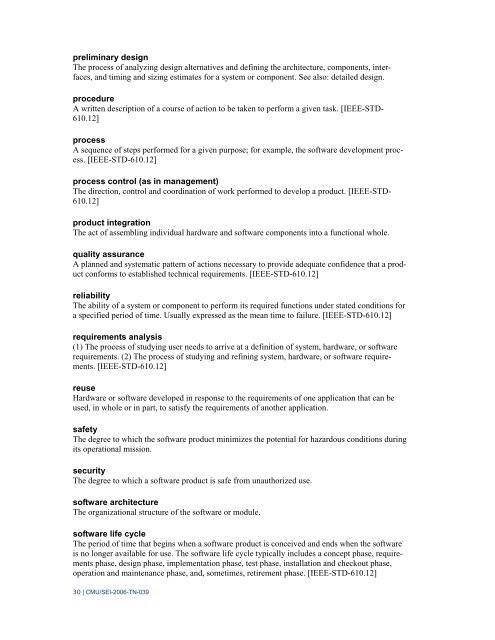A Proposed Taxonomy for Software Development Risks for High ...
A Proposed Taxonomy for Software Development Risks for High ...
A Proposed Taxonomy for Software Development Risks for High ...
You also want an ePaper? Increase the reach of your titles
YUMPU automatically turns print PDFs into web optimized ePapers that Google loves.
preliminary design<br />
The process of analyzing design alternatives and defining the architecture, components, interfaces,<br />
and timing and sizing estimates <strong>for</strong> a system or component. See also: detailed design.<br />
procedure<br />
A written description of a course of action to be taken to per<strong>for</strong>m a given task. [IEEE-STD-<br />
610.12]<br />
process<br />
A sequence of steps per<strong>for</strong>med <strong>for</strong> a given purpose; <strong>for</strong> example, the software development process.<br />
[IEEE-STD-610.12]<br />
process control (as in management)<br />
The direction, control and coordination of work per<strong>for</strong>med to develop a product. [IEEE-STD-<br />
610.12]<br />
product integration<br />
The act of assembling individual hardware and software components into a functional whole.<br />
quality assurance<br />
A planned and systematic pattern of actions necessary to provide adequate confidence that a product<br />
con<strong>for</strong>ms to established technical requirements. [IEEE-STD-610.12]<br />
reliability<br />
The ability of a system or component to per<strong>for</strong>m its required functions under stated conditions <strong>for</strong><br />
a specified period of time. Usually expressed as the mean time to failure. [IEEE-STD-610.12]<br />
requirements analysis<br />
(1) The process of studying user needs to arrive at a definition of system, hardware, or software<br />
requirements. (2) The process of studying and refining system, hardware, or software requirements.<br />
[IEEE-STD-610.12]<br />
reuse<br />
Hardware or software developed in response to the requirements of one application that can be<br />
used, in whole or in part, to satisfy the requirements of another application.<br />
safety<br />
The degree to which the software product minimizes the potential <strong>for</strong> hazardous conditions during<br />
its operational mission.<br />
security<br />
The degree to which a software product is safe from unauthorized use.<br />
software architecture<br />
The organizational structure of the software or module.<br />
software life cycle<br />
The period of time that begins when a software product is conceived and ends when the software<br />
is no longer available <strong>for</strong> use. The software life cycle typically includes a concept phase, requirements<br />
phase, design phase, implementation phase, test phase, installation and checkout phase,<br />
operation and maintenance phase, and, sometimes, retirement phase. [IEEE-STD-610.12]<br />
30 | CMU/SEI-2006-TN-039
















